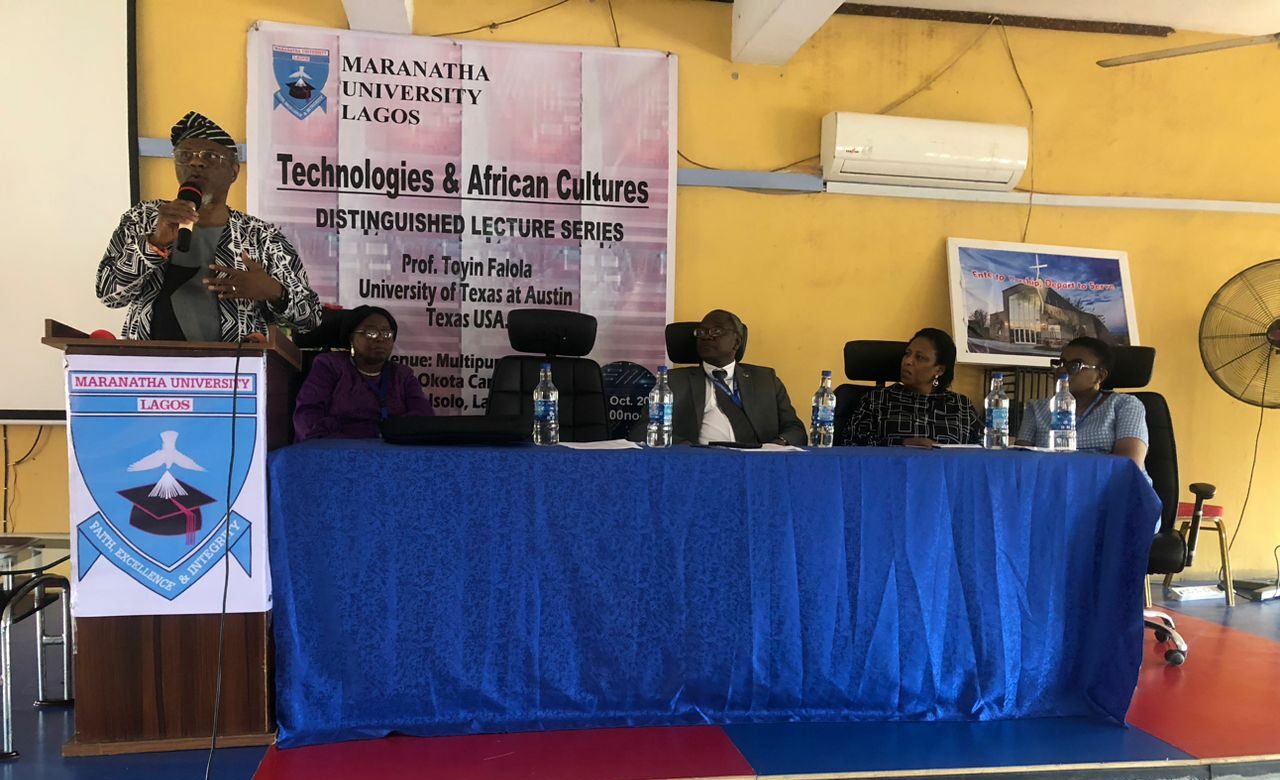Multiple-awarding professor of history, Toyin Falola, has called on relevant authorities to see to the urgent development of software and digital repositories in the preservation and revitalization of endangered African indigenous languages.
Falola, who is the Jacob and Frances Sanger Mossiker Chair in the Humanities and a Distinguished Teaching Professor at the University of Texas at Austin, made this advocacy while delivering Maranatha University’s First Distinguished Lecture at the university campus in Lekki, Lagos, on Tuesday. The event—which had foremost academics led by the university’s vice chancellor, Professor Rufus Akinyele—had policymakers and the general public in attendance.
In the lecture titled “Technologies and African Cultures”, Falola noted that the dwindling number of speakers and users of many indigenous African languages is responsible for the endangered status of these languages, arguing that “central to this position is the essential task of developing software and applications dedicated to language preservation.
These tools help communities document and impart their languages, with a specific emphasis on transmitting knowledge to younger generations. These resources include digital dictionaries, grammatical compendiums, and language acquisition applications, which facilitate the acquisition or reconnection of individuals with their ancestral languages. These resources are often customised to suit particular African languages, addressing the distinctive linguistic features and complexities associated with each language.
“Moreover, technology has enabled the establishment of digital repositories and collections comprising written and oral resources in endangered languages. These encompass a diverse range of media, such as audio recordings of narratives, musical compositions, and oral accounts of historical events, alongside digitised renditions of written manuscripts and texts. Digital repositories play a crucial role in facilitating linguistic research, educational activities, and community engagement in the study and revitalization of these languages.
“The utilisation of mobile applications and online platforms has significantly helped in preserving languages. These platforms offer convenient and engaging ways for individuals to actively interact with their languages. In addition, social media platforms facilitate the creation of connections among language communities, promoting the exchange of resources and the nurturing of linguistic pride. For example, there have been Twitter campaigns and Facebook groups specially dedicated to the promotion and revitalization of African languages. These digital spaces have provided a platform for language speakers to actively participate in efforts aimed at revitalising their respective languages.
“Significantly, technology serves as a means to overcome geographical barriers, connecting people who speak endangered languages that may be geographically dispersed across diverse regions or even continents. Virtual communities and language forums offer individuals the chance to practise their language skills, both in oral and written forms, thereby promoting the development of linguistic skills and cultivating a sense of affiliation and perpetuity.
“Nevertheless, despite the considerable potential that technology holds, there are still ongoing challenges that need to be addressed. The preservation of oral languages presents a unique set of difficulties, primarily because these linguistic systems lack a written tradition. Moreover, the digital divide poses formidable challenges, as some communities lack equitable access to the internet or the requisite technological infrastructure.”
Not losing sight of the compelling advancements made by Western technology, Falola highlights some of Africa’s remarkable indigenous technologies and knowledge systems. According to him, “Traditional African technologies demonstrated a deep understanding of local conditions, ranging from the complexities of agricultural practises that sustained communities in diverse regions to the artistry and craftsmanship evident in textiles, ceramics, and metalwork.
“Agriculture, highlighting its pivotal significance, served as a cornerstone in the sustenance of African societies. The use of traditional agricultural techniques, such as terracing, crop rotation, and irrigation systems, exemplifies the ingenuity of early farmers in their pursuit of enhancing crop productivity under diverse climatic conditions.
The implementation of these practices not only ensured the sustenance of individuals but also played a significant role in promoting the development of intricate societal structures.
“In addition to agriculture, Africa’s traditional technological repertoire encompassed remarkable architectural achievements, exemplified by the construction of awe-inspiring mud-brick and stone structures such as the renowned Great Zimbabwe or the architectural marvels found in Mali’s Timbuktu. The remarkable accomplishments in engineering showcased a profound understanding of materials and construction methodologies.
“Furthermore, it is worth noting that African cultures have demonstrated exceptional proficiency in the field of metallurgy. The practice of iron smelting was actively undertaken in the region of sub-Saharan Africa long before European presence. The Nok culture, which emerged in Nigeria around 1500 BC, exhibited remarkable artistic skill in creating terracotta sculptures. These sculptures were meticulously crafted using kilns capable of reaching temperatures exceeding 1000 degrees Celsius.
“The development and growth of trade networks constituted a noteworthy aspect of Africa’s traditional technological advancements. Longitudinal trade routes, including the trans-Saharan trade, were instrumental in facilitating the interchange of commodities and intellectual concepts across extensive geographical spans. The utilisation of technological innovations such as the camel saddle and navigational instruments expanded trade routes and fostered the exchange of cultural ideas.
“The narrative to trace the evolution of technology within African societies across history is a complex and engaging topic that challenges preconceived notions and dispels misconceptions. This narrative encapsulates a profound tale of fortitude, adaptability, and ingenuity that spans countless centuries, unveiling a continent that has been far from stagnant when confronted with the forces of technological change.
“Throughout history, African societies have achieved noteworthy technological accomplishments that have often been disregarded or underestimated. An illustrative example can be found in the Sahara Desert, where the Berber and Tuareg communities developed sophisticated water management mechanisms. These systems, known as qanats and foggaras, were ingeniously designed to harness subterranean water reservoirs, thus supporting agricultural practices and sustaining their daily existence. These innovations laid the groundwork for modern groundwater irrigation techniques.
“In West Africa, prominent empires such as Ghana, Mali, and Songhai played an active role in extensive transcontinental trade, employing sophisticated navigational instruments such as the astrolabe and magnetic compass. The application of these instruments eased the navigation of extensive territories in the Sahara and its surrounding regions for traders and explorers, thereby promoting the interchange of commodities and concepts.
In East Africa, the Swahili city-states flourished as prominent centres of commerce and cultural exchange. These city-states exhibited remarkable prowess in shipbuilding, employing advanced techniques that facilitated the creation of extensive trade networks spanning the vast expanse of the Indian Ocean. These notable maritime accomplishments predate European expeditions to the same geographical area.
“In addition, it is worth noting that the Kingdom of Axum, situated in present-day Ethiopia, achieved notable progress in the field of written communication by devising an ancient script called Ge’ez. This script played a pivotal role in documenting historical occurrences and preserving religious literature. The Ethiopian highlands also provide a remarkable example of indigenous agricultural technology through the implementation of a sophisticated system of terraced agriculture.”
YOU SHOULD NOT MISS THESE HEADLINES FROM NIGERIAN TRIBUNE
Nigeria’s current situation lamentable — Anyaoku
Chief Emeka Anyaoku, a former Secretary-General of the Commonwealth has described the current situation in…
Bukola Saraki foundation covers Mr Ibu’s medical bills
The Abubakar Bukola Saraki Foundation has fully covered the medical expenses of the…
Hold my pastor responsible if anything happens to me — Chef Dammy
Ekiti-based Nigerian chef, Damilola Adeparusi, popularly known as Chef Dammy, has stated that her…
Why Tiwa Savage may not sing for more than a year
In a move reminiscent of Afrobeat sensation Tekno, renowned Nigerian singer Tiwa Savage is facing the prospect of…
How Gomba won 2023 Nigeria Prize for Literature
THE 2023 edition of The Nigeria Prize for Literature climaxed last Friday at Eko Hotel, Victoria Island, Lagos, with…
Kidney failure, also known as end-stage renal disease (ESRD), can have various causes, but the two main types are...






